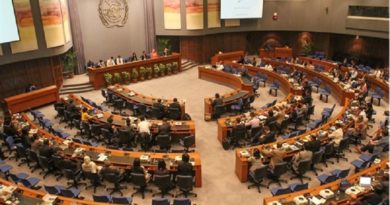UN opens exhibition on consequences of rising sea levels
The United Nations Human Settlements Programme (UN-Habitat) on Friday February 17, 2017 opened a month long exhibition on the effects of sea levels rise on people dwellings. UN-Habitat is hosting the exhibition “Where will we go?” in the Sant Pau Art Nouveau Site, in Barcelona, Spain.
The audio-visual production held under the auspices of UN-Habitat’s City Resilience Profiling Programme is by renowned photo-journalist Kadir van Lohuizen and is running from February 17th through March 17th, 2017 exploring the plight of people permanently displaced as a result of the impact of a changing climate.
The official opening of the exhibition took place on Friday, February 17 presided over by Kadir van Lohuizen, with Dan Lewis, Head of the UN Habitat’s global Risk Reduction and Resilience programmes, and Arnau Queralt i Bassa, Director of the Advisory Council for Sustainable Development of Catalonia (CADS).
“Where Will We Go?” Is a visceral and visual statement on the plight of people confronting the loss of their land and livelihoods as a result of sea level rise and coastal erosion.
It provides vivid visual coverage of how climate change is already affecting places where people live- Greenland with its melting glaciers, Kiribati, Fiji, the Carterets Islands in Bougainville, Bangladesh, the Guna Yala archipelago in Panama, the United Kingdom and the United States. Before the sea floods land permanently, sea water intrudes at high tides, making once-fertile land no longer viable for crops and water undrinkable. The exhibition showcases the lives of people who still live in affected areas as well as those who have already moved to safer ground.
“Where will we go?” Highlights both the immense complexities associated with the forced displacement of people, as well as the implications for their human rights.
Speaking during the occasion Josep Tardà Pau, Director of Communication and Institutional Relations, Sant Pau Art Nouveau Site said: “This pavilion, which once housed surgery facilities, will someday be restored. Likewise, I hope that the endangered lives and livelihoods shown so vividly in these images might also recover full health and vitality in coming years, thanks in part to your important work.”
On his part Lewis said that 12 million people were imminently threatened by climate change have left homes or are planning to do so.
“The future happened quite some time ago for many people around the world being uprooted by climate change,” he said.
“It took me 2 years to complete this project, cooperating with New York Times. I really engaged in showing what is happening right now. The sea level is rising, we have to act now,” said van Lohuizen.
Arnau Queralt of CADS said, “This exhibition inviting us to leave our comfort zone, to be brave to face the reality of climate change, not only about developing countries, but also us and especially to young students here, to let you to be aware of the future.”




